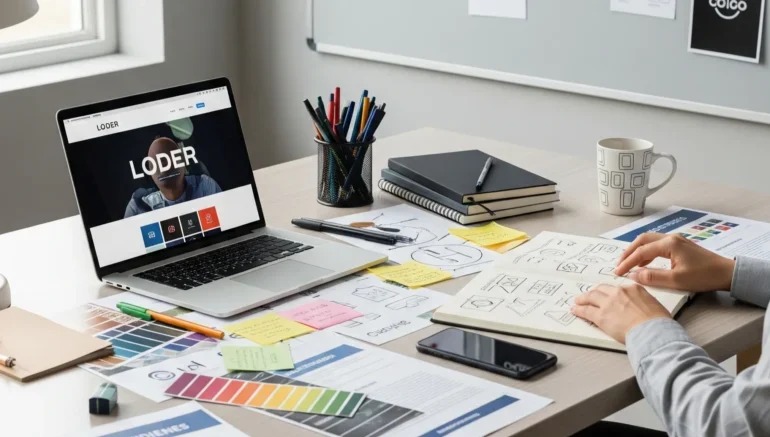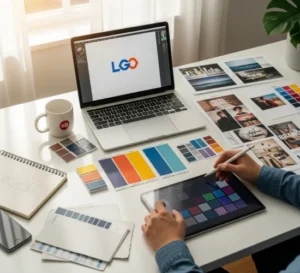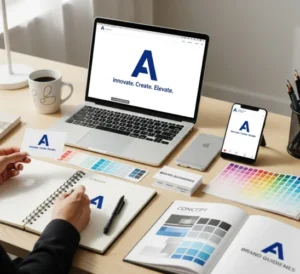
How To Make Your Logo Work for Your Brand
Your logo is often the first thing people notice about your business, and knowing how to make your logo work for brand is important for standing out. It’s more than just a symbol or image, it reflects your brand’s personality, values, and mission. A well designed logo can make your business memorable, build trust with customers, and create a lasting impression in a crowded market. Many businesses focus heavily on marketing but overlook how their logo can actively promote their brand. When used correctly, a logo becomes a key tool to attract attention and strengthen your brand identity. It can communicate what your business stands for in a single glance. Every small detail, from colors to shapes, contributes to making a logo work effectively for your brand.
Using a logo effectively goes beyond placing it on your website or social media accounts. It requires consistent choices across all platforms to make sure your brand is represented clearly. This includes selecting the right colors, fonts, and design elements that align with your business identity. Each time someone sees your logo, they should immediately recognize your brand and feel a connection. A well planned logo can also help support marketing efforts across different channels. With the right approach, a logo does more than look good, it actively helps grow your business and attract loyal customers. Maintaining this consistency is key to building a strong and trustworthy brand presence.
Here’s How To Make Your Logo Work for Your Brand
1. Keep Your Logo Simple and Clear
 A simple logo is easier to remember and instantly recognizable. Complicated designs can confuse your audience and make your brand harder to identify. A clear logo communicates your message quickly without unnecessary elements. Simplicity allows people to focus on what your brand represents instead of being distracted by too many details. Many successful brands have simple logos, proving that minimalism can still be creative and effective.
A simple logo is easier to remember and instantly recognizable. Complicated designs can confuse your audience and make your brand harder to identify. A clear logo communicates your message quickly without unnecessary elements. Simplicity allows people to focus on what your brand represents instead of being distracted by too many details. Many successful brands have simple logos, proving that minimalism can still be creative and effective.
To make it simple and clear, consider these tips:
- Use clean lines and readable fonts that are easy to see at any size.
- Limit the number of colors to maintain a cohesive and professional look.
- Avoid clutter by removing unnecessary symbols or extra design elements.
- Make sure your logo works well in black and white for versatile applications.
- Test it in small sizes to make sure it remains clear and recognizable.
- Choose a design that reflects your brand personality without overcomplicating it.
2. Use Colors That Represent Your Brand
Colors have a strong impact on how people feel about your business. Choosing the right color scheme can make your logo memorable and influence customer decisions. Each color communicates a different message, so it’s important to match them with your brand identity. Consistent color use helps your audience recognize your business instantly, even without seeing the name. A thoughtful color choice can make your brand feel trustworthy, energetic, or approachable, depending on the tone you want.
 Tips for selecting colors for it:
Tips for selecting colors for it:
- Red can feel bold, exciting, or attention grabbing.
- Blue is associated with trust, professionalism, and stability.
- Green connects with nature, health, or sustainability.
- Yellow can feel cheerful, friendly, or optimistic.
- Use complementary colors for balance and harmony.
- Stick to 2-3 main colors for consistency across platforms.
3. Make It Adaptable Across Platforms
Your logo needs to look good everywhere, from your website and social media to business cards and merchandise. A flexible logo is the key for your brand to appear professional in every setting. Adaptable logos can maintain quality in different sizes and formats, making them more practical for marketing. Using multiple versions allows it to fit various platforms without losing clarity. This versatility also makes your brand appear reliable and thoughtfully designed.
 Tips to make your logo adaptable:
Tips to make your logo adaptable:
- Create versions for light and dark backgrounds.
- Use vector files for scalability without losing quality.
- Test readability on mobile devices and smaller screens.
- Check if it works well in print materials like brochures or posters.
- Keep design elements simple for easy resizing.
- Prepare a square or icon version for social media avatars.
4. Place The Logo Strategically
Having a logo is not enough; placement is just as important. Your logo should appear where your audience is most likely to notice it. Consistent placement across platforms builds familiarity and strengthens your brand identity. Proper positioning ensures your logo makes a small but meaningful connection every time it is seen. Over time, repeated exposure helps your business stay memorable and recognizable.
 Tips for strategic logo placement:
Tips for strategic logo placement:
- Place it at the top of your website and social media pages.
- Include it in email signatures and newsletters.
- Feature it on product packaging and promotional materials.
- Use it on invoices, receipts, and branded documents.
- Keep a consistent size and spacing in all placements.
5. Reflects Your Brand Personality
A logo should match your brand’s personality and tone. If your brand is playful, consider fun fonts or lively colors. If your brand is professional, a clean, minimal design is often better. A logo aligned with your personality helps your audience relate to your business. Customers are more likely to trust and support brands that feel authentic and consistent. The right design choices make a logo a reflection of your brand values.
 Tips for reflecting your brand personality:
Tips for reflecting your brand personality:
- Match fonts and shapes with your business tone.
- Use symbols that represent your products or services.
- Avoid trendy designs that may feel outdated quickly.
- Consider your audience’s preferences and expectations.
- Make sure it aligns with all other brand visuals.
6. Ensure Consistency Everywhere
Consistency is important to make your logo recognizable. If it looks different on different platforms, it can confuse customers and weaken your brand. Keeping design elements uniform builds trust and strengthens your brand identity. A consistent logo creates a visual cue that reminds people of your business instantly. This repeated exposure over time increases recognition and loyalty.
Tips to ensure consistency:
- Stick to the same colors, fonts, and design elements.
- Create a style guide for logo usage across all materials.
- Ensure employees and partners know the rules for using the logo.
- Use the same logo version across digital and print channels.
- Avoid altering shapes or proportions unnecessarily.
- Check all marketing materials for consistent logo placement.
7. Combine Your Logo With a Tagline
A tagline can complement it by explaining what your business does. It makes your logo more informative and memorable. A clear and concise tagline helps people quickly understand your brand’s value. When paired with it, it creates a stronger impression and communicates your message effectively. Taglines also help differentiate your business from competitors.
 Tips for combining a logo with a tagline:
Tips for combining a logo with a tagline:
- Keep it short and easy to remember.
- Use words that clearly communicate your brand value.
- Make sure it works visually with your logo design.
- Place it where it’s easily readable and balanced with the logo.
- Avoid overly complex or vague phrases.
8. Protect Your Logo
It is a key part of your brand identity, so protecting it is important. A protected logo ensures your brand remains unique and credible. Without proper protection, others could misuse it, weakening your reputation. Taking legal and practical steps helps maintain your brand’s integrity. Customers will see your logo as a mark of quality and professionalism.
Tips for protecting your logo:
- Trademark it to prevent copying.
- Monitor online use to detect unauthorized versions.
- Set clear rules for partners or affiliates using the logo.
- Keep original design files secure for reference.
- Document logo usage in contracts with collaborators.
- Update protection measures if it evolves.
9. Update Your Logo When Needed
Sometimes a logo needs a refresh to stay current and appealing. Updating doesn’t mean a complete redesign, it can involve subtle adjustments to modernize your look. Small changes can improve clarity, readability, and relevance for digital platforms. A refreshed logo can also attract new customers while keeping existing ones engaged. Updating thoughtfully shows your brand is active and evolving.
 Tips for updating your logo:
Tips for updating your logo:
- Refresh colors to align with current trends.
- Simplify design details for a cleaner appearance.
- Adjust for digital platforms like mobile or social media.
- Retain elements that make your brand recognizable.
- Test new designs with your audience for feedback.
1o. Use Your Logo to Tell Your Brand Story
It is an opportunity to visually share your brand story. Colors, shapes, and symbols can all reflect your business values and mission. A logo that tells a story creates a stronger connection with your audience. Customers are more likely to remember brands that have meaning behind their visuals. Thoughtful design can communicate professionalism, trust, or creativity depending on your brand personality.
 Tips for using your logo to tell your story:
Tips for using your logo to tell your story:
- Include symbols that reflect your products or industry.
- Use colors that align with your brand personality.
- Consider design elements showing your business history or vision.
- Make sure it reflects your company values clearly.
- Avoid confusing or unrelated imagery.
- Test if your audience understands the story behind the logo.
Conclusion
A well designed logo does more than look appealing, it actively supports your business growth and builds trust with your audience. By following these strategies, you can ensure your logo work for brand is effective across all platforms and marketing materials. From choosing the right colors and fonts to placing it strategically, every detail matters in making it memorable. Consistency, adaptability, and a clear reflection of your brand personality help customers recognize and connect with your business. Protecting and updating your logo keeps it relevant and credible over time. When combined with a strong tagline or a meaningful brand story, it becomes a powerful tool for communication. How do you use your logo in your business? Share your thoughts in the comments and let’s discuss ways to make a logo work even harder for a brand.
Read Next: 10 Outsourcing Services Every Startup Should Consider










